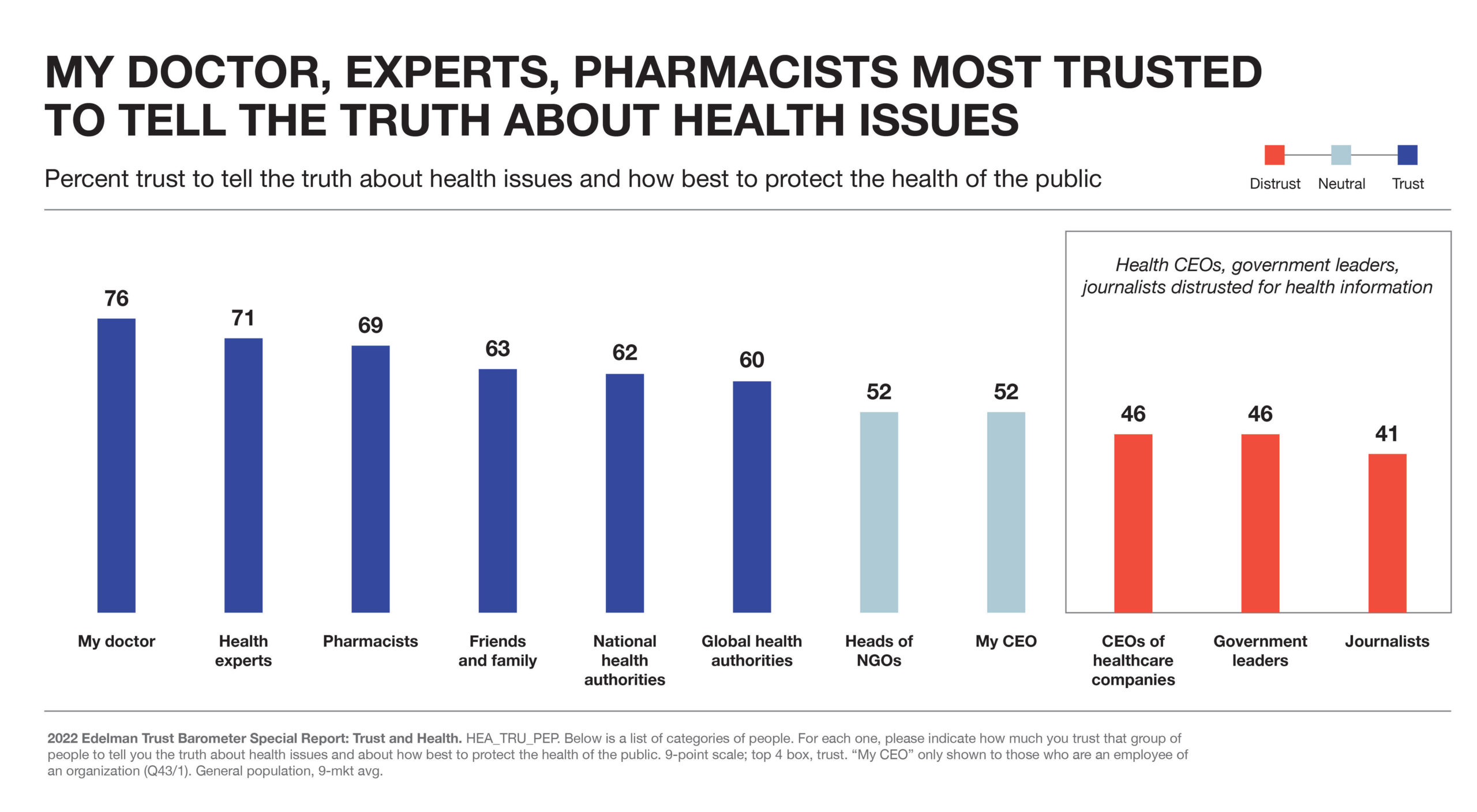In the pharmaceutical industry, our primary focus is to educate providers and patients about the safety and efficacy of our treatment option(s).
While this is an important objective, some critical barriers that have been identified, include:
- Data has revealed a significant trust gap between pharmaceutical companies and people working in healthcare. More specifically, 75% of physicians do not trust the information provided to them by marketers.
- As pharma companies and healthcare communications professionals, we aren’t a patient’s preferred source of education. Less than one out of two patients trust pharmaceutical companies, and over 35% state that they outright distrust them.
These data suggest that neither the effectiveness of our education nor the strength of our brand campaigns can compensate for a lack of trust. Without a foundation of trust, providers and patients may not hear us regardless of the clarity of our messaging or the innovation of our designs. We want to be viewed by providers as valued partners in patient care, but how do we reestablish the trust this partnership depends upon?
Every Problem Is an Opportunity
“Promote trust by helping others, even it if provides little direct benefit to you.”
Our common goal is to ensure that patients receive the best care possible. It is why we are here; it is what pulled us to our field. Hidden beneath endless daily meeting invites and our overflowing inboxes is a visceral need to help those around us. The good news is, we can help others and build trust at the same time.
Lead with your heart and reestablish the trust of the patient and provider by providing unbranded, valuable education that optimizes provider practices, improves patient care and, potentially, patient outcomes. Consider supporting the best practices of providers, and the best interests of patients, with the following three initiatives.
1. Shared Decision-Making Tools and Resources
Shared decision-making (SDM) is the process in which a provider relays clear and complete medical information to their patients about their treatment and patients provide information on their preferences. Recognized as the ideal model of communication between patients and healthcare providers, SDM has been found to improve both patient healthcare satisfaction and patient treatment adherence. We can play an important role in enabling SDM by providing tools and resources that support it, including:
- Provider/patient discussion aids.
- Information for providers regarding best practices for SDM and the potential benefits that may result.
- Education that empowers patients to have an active voice in treatment decisions. In these resources, let patients know that providers want to hear their treatment goals, preferences, and questions. Open the door to conversation so patients leave well informed and confident in their care plan.
2. Customized Patient Education
In a recent study, only 61% of Americans reported feeling confident in their ability to make informed healthcare decisions for themselves and their families, down 10% from 2017. Patients need more education, and they need to receive this education from their most trusted source, their doctor (Figure 1).
 More than three out of four patients trust information received from their doctor above all else. Help doctors convey this information to their patients. Ask what type of educational resources they need to help patients understand their disease state and treatment options, then equip your reps to deliver it.
More than three out of four patients trust information received from their doctor above all else. Help doctors convey this information to their patients. Ask what type of educational resources they need to help patients understand their disease state and treatment options, then equip your reps to deliver it.
3. An Inclusive Approach
Over time, mistrust in healthcare has become a true barrier to patient care. An inclusive approach can help earn the trust of those around us. Recognize populations that are underserved and underrepresented and seek their insights to help guide the direction of our future products and services.
Acknowledgment of other determinants of health is important too. In response to a 2022 Edelman Trust Barometer Special Report survey:
- 55% of patients in the U.S. reported cost as a barrier to taking care of their health, including the cost of healthy food options, good healthcare, and treatment.
- 48% of patients in the U.S. reported information to be a barrier to taking care of their health, including lack of information, changing health recommendations, and contradictory expert advice.
Patients also stated that to earn or keep their trust, healthcare companies needed to address other determinants of health including poverty and income inequality, high cost of nutritious foods, and racial injustice. The pharma industry has done significant work to reduce health inequities, for example, improving access to medicines with reduced-pay programs, incorporating principles of health literacy in patient educational resources, and offering these resources in multiple languages. However, more work is to be done. We can encourage and empower patients, build relationships, and help create healthier communities with resources designed and placed where they can reach those who are often overlooked and underserved.
It’s All About Balance
Although our primary focus must remain the creation of well-balanced, branded patient and professional resources, this cannot be done in a silo. Providers are seeking trusted partners who come to the table with a balance of pertinent branded information and unbranded strategic initiatives designed to advance healthcare practices.
Those advancements may come in many forms, including more effective point-of-care discussions between patients and providers, vital patient education, and the inclusion of underserved and overlooked populations in our patient education and outreach practices. Let’s re-establish provider and patient trust with our commitment to healthier communities and better healthcare practices for all. Then, they will truly listen.









